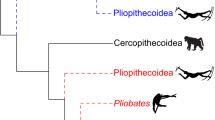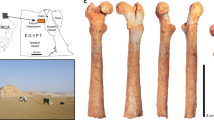Abstract
The middle Eocene primate family Eosimiidae, which is known from sites in central and eastern China1,2 and Myanmar3, is central to efforts to reconstruct the origin and early evolution of anthropoid or ‘higher’ primates (monkeys, apes and humans)1,2,3,4,5,6. Previous knowledge of eosimiid anatomy has been restricted to the dentition1,2,3,7 and an isolated petrosal bone5, and this limited anatomical information has led to conflicting interpretations of early anthropoid phylogeny1,2,3,4,5,6,8,9. Here we describe foot bones of Eosimias from the same middle Eocene sites in China that yield abundant dental remains of this primate. Tarsals of Eosimias show derived anatomical traits that are otherwise restricted to living and fossil anthropoids. These new fossils substantiate the anthropoid status of Eosimias and clarify the phylogenetic position of anthropoids with respect to other major primate clades. Early anthropoids possessed a mosaic of primitive and derived traits in their postcranial skeletons, reflecting their derivation from haplorhine ancestors that retained many prosimian-like features.
This is a preview of subscription content, access via your institution
Access options
Subscribe to this journal
Receive 51 print issues and online access
$199.00 per year
only $3.90 per issue
Buy this article
- Purchase on Springer Link
- Instant access to full article PDF
Prices may be subject to local taxes which are calculated during checkout




Similar content being viewed by others
References
Beard, K. C., Qi, T., Dawson, M. R., Wang, B. & Li, C. A diverse new primate fauna from middle Eocene fissure-fillings in southeastern China. Nature 368, 604– 609 (1994).
Beard, K. C., Tong, Y., Dawson, M. R., Wang, J. & Huang, X. Earliest complete dentition of an anthropoid primate from the late middle Eocene of Shanxi Province, China. Science 272, 82–85 (1996).
Jaeger, J.-J. et al. A new primate from the middle Eocene of Myanmar and the Asian early origin of anthropoids. Science 286, 528–530 (1999).
Ross, C., Williams, B. & Kay, R. F. Phylogenetic analysis of anthropoid relationships. J. Hum. Evol. 35, 221–306 (1998).
MacPhee, R. D. E., Beard, K. C. & Qi, T. Significance of primate petrosal from middle Eocene fissure-fillings at Shanghuang, Jiangsu Province, People's Republic of China. J. Hum. Evol. 29, 501–514 ( 1995).
Kay, R. F., Ross, C. & Williams, B. A. Anthropoid origins. Science 275, 797–804 (1997).
Tong, Y. Middle Eocene small mamals from Liguanziao Basin of Henan Province and Yuanqu Basin of Shanxi Province, central China. Paleontologia Sinica. 26, 1–256 (1997).
Rasmussen, D. T. in Anthropoid Origins (eds Fleagle, J. G. & Kay, R. F.) 335–360 (Plenum, New York, 1994).
Godinot, M. in Anthropoid Origins (eds Fleagle, J. G. & Kay, R. F.) 235– 295 (Plenum, New York, 1994).
Lewis, O. J. The joints of the evolving foot. Part III. The fossil evidence. J. Anat. 131, 275–298 ( 1980).
Martin, R. D. Primate Origins and Evolution: a Phylogenetic Reconstruction (Princeton Univ. Press, Princeton, 1990).
Decker, R. L. & Szalay, F. S. in Primate Locomotion (ed. Jenkins, F. A. Jr) 261–291 (Academic, New York, 1974).
Dagosto, M. Implications of postcranial evidence for the origin of euprimates. J. Hum. Evol. 17, 35–56 (1988).
Beard, K. C., Dagosto, M., Gebo, D. L. & Godinot, M. Interrelationships among primate higher taxa. Nature 331, 712 –714 (1988).
Dagosto, M. & Gebo, D. L. in Anthropoid Origins (eds Fleagle, J. G. & Kay, R. F.) 567–593 (Plenum, New York, 1994).
Gebo, D. L. Anthropoid origins—the foot evidence. J. Hum. Evol. 15, 421–430 (1986).
Gebo, D. L. Foot morphology and locomotor adaptation in Eocene primates. Folia Primatol. 50, 3–41 ( 1988).
Swofford, D. Phylogenetic Analysis Using Parsimony Version 4.0 (Sinauer, Sunderland, Massachusetts, 1998).
Simons, E. L. & Rasmussen, D. T. Cranial morphology of Aegyptopithecus and Tarsius and the question of the tarsier–anthropoidean clade. Am. J. Phys. Antrhopol. 79, 1– 23 (1989).
Rasmussen, D. T. The phylogenetic position of Mahgarita stevensi: Protoanthropoid or lemuroid? Int. J. Primatol. 11, 439– 469 (1990).
Simons, E. L. Skulls and anterior teeth of Catopithecus (Primates: Anthropoidea) from the Eocene and anthropoid origins. Science 268 , 1885–1888 (1995).
Gingerich, P. D. in Evolutionary Biology of the New World Monkeys and Continental Drift (eds Ciochon, R. L. & Chiarelli, A. B.) 123– 138 (Plenum, New York, 1980).
Rosenberger, A. L. & Szalay, F. S. in Evolutionary Biology of New World Monkeys and Continental Drift (eds Ciochon, R. L. & Chiarelli, A. B.) 139–157 (Plenum, New York, 1980).
Cartmill, M. & Kay, R. F. in Recent Advances in Primatology Vol. 3 (eds Chivers, D. J. & Joysey, K. A.) 205– 213 (Academic, London, 1978).
Cartmill, M. in Evolutionary Biology of the New World Monkeys and Continental Drift (eds Ciochon, R. L. & Chiarelli, A. B.) 243–274 (Plenum, New York, 1980).
Ross, C. in Anthropoid Origins (eds Fleagle, J. G. & Kay, R. F.) 469– 547 (Plenum, New York, 1994).
Beard, K. C., Krishtalka, L. & Stucky, R. K. First skulls of the early Eocene primate Shoshonius cooperi and the anthropoid–tarsier dichotomy. Nature 349, 64–67 ( 1991).
Beard, K. C. & MacPhee, R. D. E. in Anthropoid Origins (eds Fleagle, J. G. & Kay, R. F.) 55–97 (Plenum, New York, 1994).
Fleagle, J. G. Primate Adaptation and Evolution 2nd edn (Academic, San Diego, 1999).
Dagosto, M. & Terranova, C. J. Estimating the body size of Eocene primates: A comparison of results from dental and postcranial variables. Int. J. Primatol. 13, 307– 344 (1992).
Acknowledgements
We thank the Leakey Foundation (D.L.G. and M.D.) and the National Science Foundation (K.C.B.) for their financial support. We also thank our Chinese colleagues, particularly Guo Jianwei, for helping to wash, screen and sort the specimens from the Shanghuang fissures. We also thank Kim Reed-Deemer for her artwork.
Author information
Authors and Affiliations
Corresponding author
Supplementary information
41586_2000_BF35005066_MOESM1_ESM.doc
Table 1: Calcaneal measurements (in mm) and ratios for the eosimiid calcanei. The extant platyrrhine Cebuella is presented for comparison. Table 2: Measurements and indices for eosimiid tali. All catalogue numbers are from the IVPP.
Rights and permissions
About this article
Cite this article
Gebo, D., Dagosto, M., Beard, K. et al. The oldest known anthropoid postcranial fossils and the early evolution of higher primates. Nature 404, 276–278 (2000). https://doi.org/10.1038/35005066
Received:
Accepted:
Issue Date:
DOI: https://doi.org/10.1038/35005066
This article is cited by
-
The phylogenetic system of primates—character evolution in the light of a consolidated tree
Organisms Diversity & Evolution (2016)
-
The oldest known primate skeleton and early haplorhine evolution
Nature (2013)
-
Calcaneal proportions in primates and locomotor inferences in Anchomomys and other Palaeogene Euprimates
Swiss Journal of Palaeontology (2012)
-
A role for host–parasite interactions in the horizontal transfer of transposons across phyla
Nature (2010)
-
Simulating the fine-branch arboreal niche and exercising mice to elicit above-branch quadrupedal grasping and climbing
Lab Animal (2009)
Comments
By submitting a comment you agree to abide by our Terms and Community Guidelines. If you find something abusive or that does not comply with our terms or guidelines please flag it as inappropriate.



